ITECH 1100 Understanding the Digital Revolution: VR in Film & TV
VerifiedAdded on 2023/06/04
|8
|1745
|311
Report
AI Summary
This report examines the potential impact of Virtual Reality (VR) technology on the film and television industries. It describes VR technology, highlighting its ability to provide immersive experiences and alternative realities. The report brainstorms potential changes, such as the shift from passive viewing to active experiencing, the need for higher quality film and TV production standards (e.g., higher frame rates, 3D integration), and the evolving role of camera control, potentially shifting from filmmakers to viewers. The report also addresses constraints, including video quality limitations, potential social consequences like addiction to virtual environments, and the high cost of VR equipment. Finally, it identifies key process components like smart glasses and 3D screens and describes the major changes VR will bring to the film and TV viewing experience. Desklib offers a wide range of solved assignments and past papers for students.
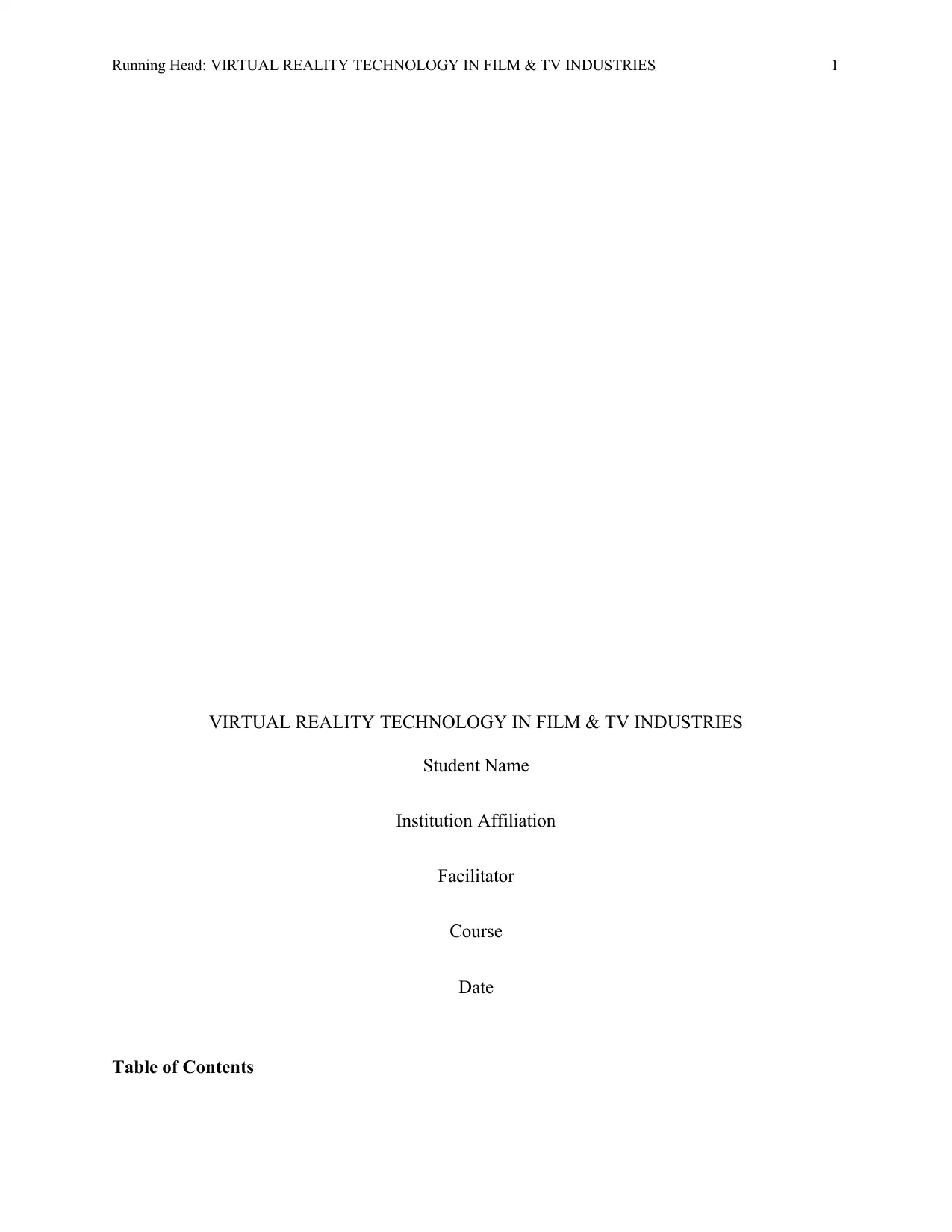
Running Head: VIRTUAL REALITY TECHNOLOGY IN FILM & TV INDUSTRIES 1
VIRTUAL REALITY TECHNOLOGY IN FILM & TV INDUSTRIES
Student Name
Institution Affiliation
Facilitator
Course
Date
Table of Contents
VIRTUAL REALITY TECHNOLOGY IN FILM & TV INDUSTRIES
Student Name
Institution Affiliation
Facilitator
Course
Date
Table of Contents
Paraphrase This Document
Need a fresh take? Get an instant paraphrase of this document with our AI Paraphraser
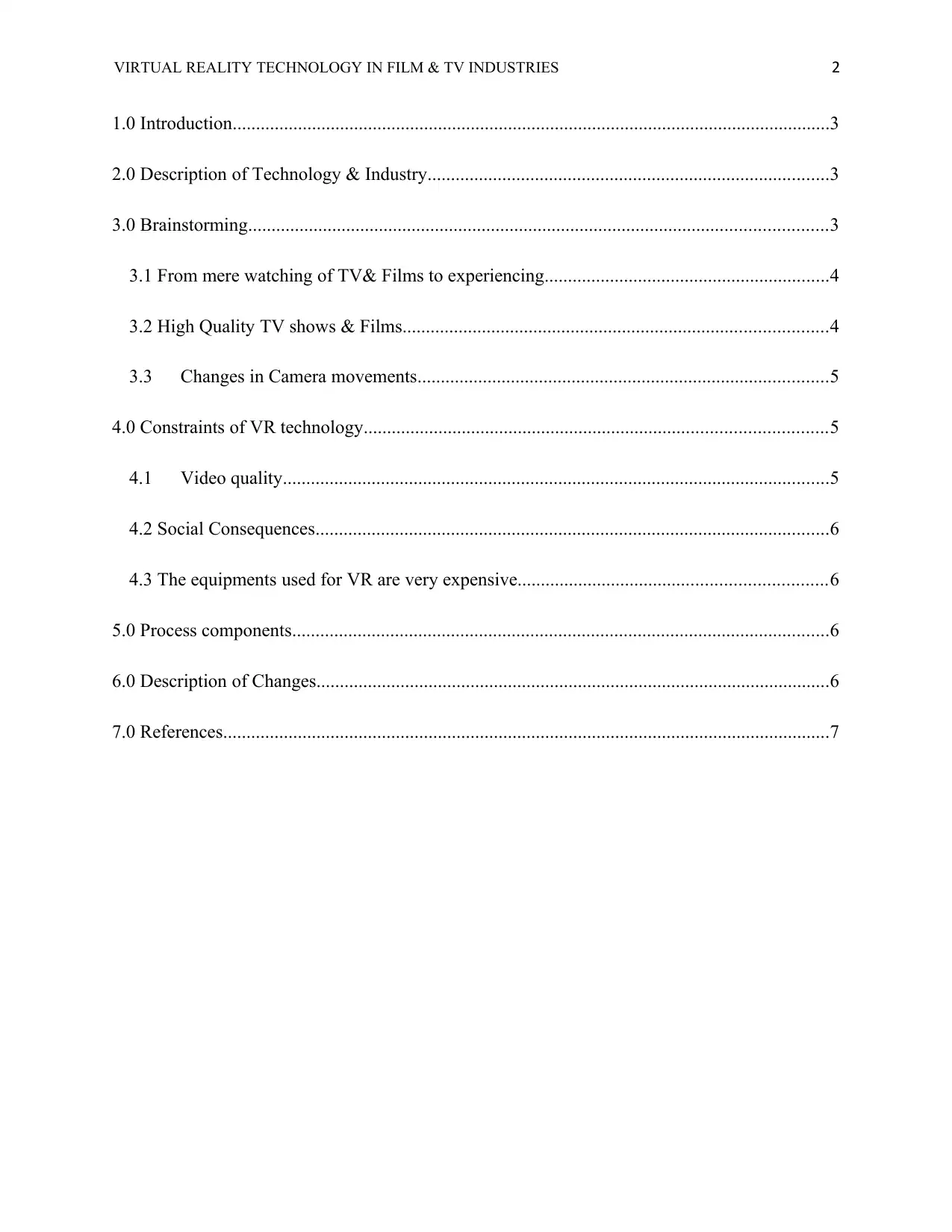
VIRTUAL REALITY TECHNOLOGY IN FILM & TV INDUSTRIES 2
1.0 Introduction................................................................................................................................3
2.0 Description of Technology & Industry......................................................................................3
3.0 Brainstorming............................................................................................................................3
3.1 From mere watching of TV& Films to experiencing.............................................................4
3.2 High Quality TV shows & Films...........................................................................................4
3.3 Changes in Camera movements........................................................................................5
4.0 Constraints of VR technology...................................................................................................5
4.1 Video quality.....................................................................................................................5
4.2 Social Consequences..............................................................................................................6
4.3 The equipments used for VR are very expensive..................................................................6
5.0 Process components...................................................................................................................6
6.0 Description of Changes..............................................................................................................6
7.0 References..................................................................................................................................7
1.0 Introduction................................................................................................................................3
2.0 Description of Technology & Industry......................................................................................3
3.0 Brainstorming............................................................................................................................3
3.1 From mere watching of TV& Films to experiencing.............................................................4
3.2 High Quality TV shows & Films...........................................................................................4
3.3 Changes in Camera movements........................................................................................5
4.0 Constraints of VR technology...................................................................................................5
4.1 Video quality.....................................................................................................................5
4.2 Social Consequences..............................................................................................................6
4.3 The equipments used for VR are very expensive..................................................................6
5.0 Process components...................................................................................................................6
6.0 Description of Changes..............................................................................................................6
7.0 References..................................................................................................................................7
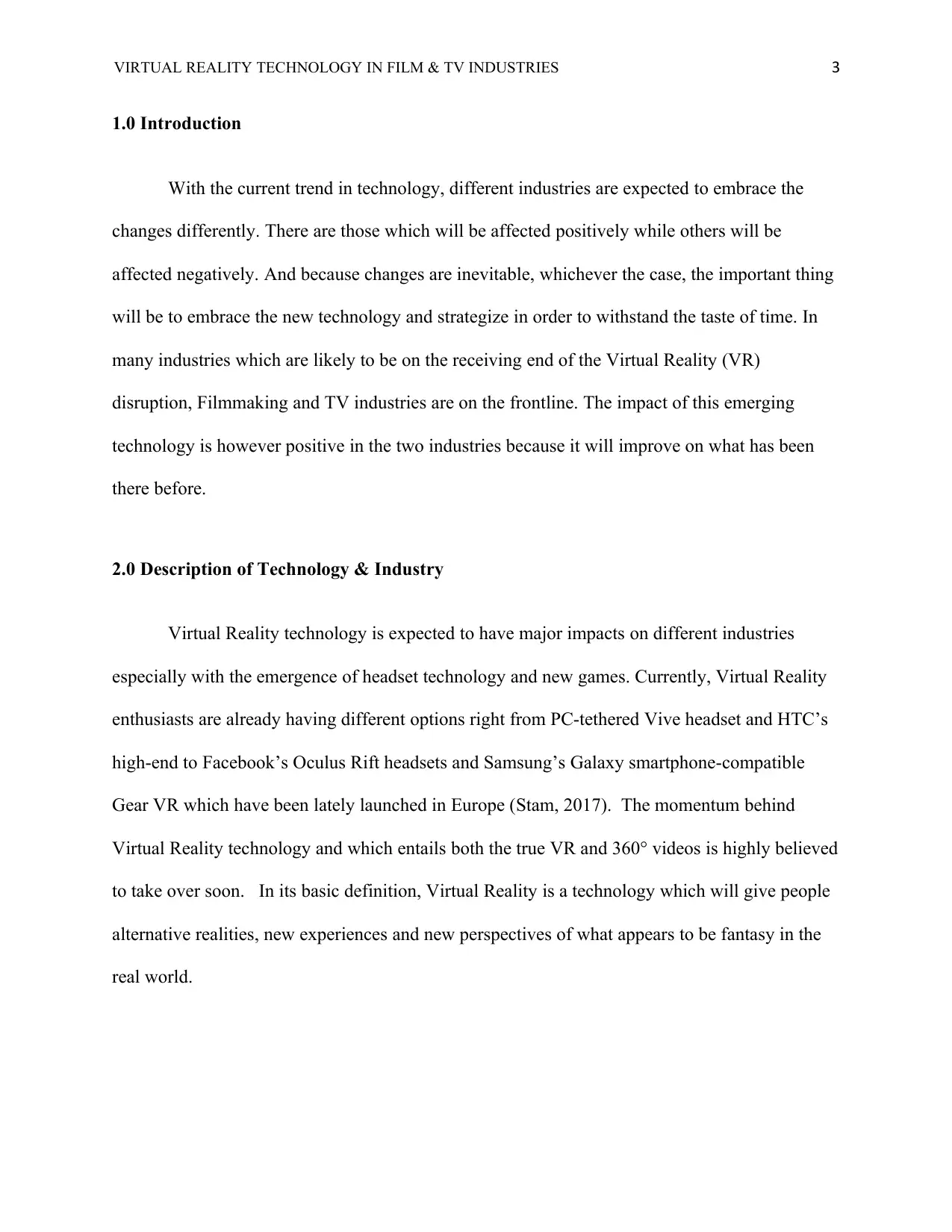
VIRTUAL REALITY TECHNOLOGY IN FILM & TV INDUSTRIES 3
1.0 Introduction
With the current trend in technology, different industries are expected to embrace the
changes differently. There are those which will be affected positively while others will be
affected negatively. And because changes are inevitable, whichever the case, the important thing
will be to embrace the new technology and strategize in order to withstand the taste of time. In
many industries which are likely to be on the receiving end of the Virtual Reality (VR)
disruption, Filmmaking and TV industries are on the frontline. The impact of this emerging
technology is however positive in the two industries because it will improve on what has been
there before.
2.0 Description of Technology & Industry
Virtual Reality technology is expected to have major impacts on different industries
especially with the emergence of headset technology and new games. Currently, Virtual Reality
enthusiasts are already having different options right from PC-tethered Vive headset and HTC’s
high-end to Facebook’s Oculus Rift headsets and Samsung’s Galaxy smartphone-compatible
Gear VR which have been lately launched in Europe (Stam, 2017). The momentum behind
Virtual Reality technology and which entails both the true VR and 360° videos is highly believed
to take over soon. In its basic definition, Virtual Reality is a technology which will give people
alternative realities, new experiences and new perspectives of what appears to be fantasy in the
real world.
1.0 Introduction
With the current trend in technology, different industries are expected to embrace the
changes differently. There are those which will be affected positively while others will be
affected negatively. And because changes are inevitable, whichever the case, the important thing
will be to embrace the new technology and strategize in order to withstand the taste of time. In
many industries which are likely to be on the receiving end of the Virtual Reality (VR)
disruption, Filmmaking and TV industries are on the frontline. The impact of this emerging
technology is however positive in the two industries because it will improve on what has been
there before.
2.0 Description of Technology & Industry
Virtual Reality technology is expected to have major impacts on different industries
especially with the emergence of headset technology and new games. Currently, Virtual Reality
enthusiasts are already having different options right from PC-tethered Vive headset and HTC’s
high-end to Facebook’s Oculus Rift headsets and Samsung’s Galaxy smartphone-compatible
Gear VR which have been lately launched in Europe (Stam, 2017). The momentum behind
Virtual Reality technology and which entails both the true VR and 360° videos is highly believed
to take over soon. In its basic definition, Virtual Reality is a technology which will give people
alternative realities, new experiences and new perspectives of what appears to be fantasy in the
real world.
⊘ This is a preview!⊘
Do you want full access?
Subscribe today to unlock all pages.

Trusted by 1+ million students worldwide
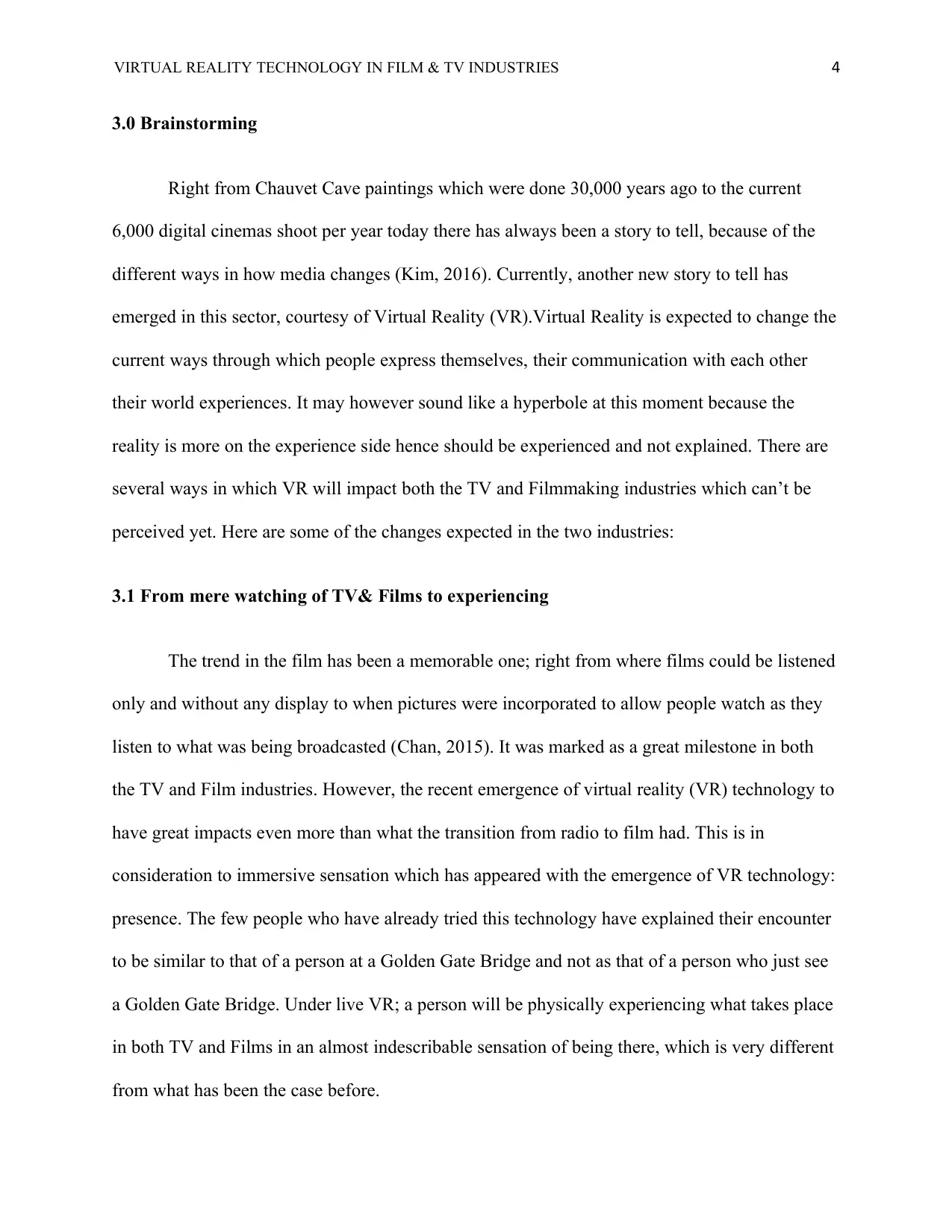
VIRTUAL REALITY TECHNOLOGY IN FILM & TV INDUSTRIES 4
3.0 Brainstorming
Right from Chauvet Cave paintings which were done 30,000 years ago to the current
6,000 digital cinemas shoot per year today there has always been a story to tell, because of the
different ways in how media changes (Kim, 2016). Currently, another new story to tell has
emerged in this sector, courtesy of Virtual Reality (VR).Virtual Reality is expected to change the
current ways through which people express themselves, their communication with each other
their world experiences. It may however sound like a hyperbole at this moment because the
reality is more on the experience side hence should be experienced and not explained. There are
several ways in which VR will impact both the TV and Filmmaking industries which can’t be
perceived yet. Here are some of the changes expected in the two industries:
3.1 From mere watching of TV& Films to experiencing
The trend in the film has been a memorable one; right from where films could be listened
only and without any display to when pictures were incorporated to allow people watch as they
listen to what was being broadcasted (Chan, 2015). It was marked as a great milestone in both
the TV and Film industries. However, the recent emergence of virtual reality (VR) technology to
have great impacts even more than what the transition from radio to film had. This is in
consideration to immersive sensation which has appeared with the emergence of VR technology:
presence. The few people who have already tried this technology have explained their encounter
to be similar to that of a person at a Golden Gate Bridge and not as that of a person who just see
a Golden Gate Bridge. Under live VR; a person will be physically experiencing what takes place
in both TV and Films in an almost indescribable sensation of being there, which is very different
from what has been the case before.
3.0 Brainstorming
Right from Chauvet Cave paintings which were done 30,000 years ago to the current
6,000 digital cinemas shoot per year today there has always been a story to tell, because of the
different ways in how media changes (Kim, 2016). Currently, another new story to tell has
emerged in this sector, courtesy of Virtual Reality (VR).Virtual Reality is expected to change the
current ways through which people express themselves, their communication with each other
their world experiences. It may however sound like a hyperbole at this moment because the
reality is more on the experience side hence should be experienced and not explained. There are
several ways in which VR will impact both the TV and Filmmaking industries which can’t be
perceived yet. Here are some of the changes expected in the two industries:
3.1 From mere watching of TV& Films to experiencing
The trend in the film has been a memorable one; right from where films could be listened
only and without any display to when pictures were incorporated to allow people watch as they
listen to what was being broadcasted (Chan, 2015). It was marked as a great milestone in both
the TV and Film industries. However, the recent emergence of virtual reality (VR) technology to
have great impacts even more than what the transition from radio to film had. This is in
consideration to immersive sensation which has appeared with the emergence of VR technology:
presence. The few people who have already tried this technology have explained their encounter
to be similar to that of a person at a Golden Gate Bridge and not as that of a person who just see
a Golden Gate Bridge. Under live VR; a person will be physically experiencing what takes place
in both TV and Films in an almost indescribable sensation of being there, which is very different
from what has been the case before.
Paraphrase This Document
Need a fresh take? Get an instant paraphrase of this document with our AI Paraphraser
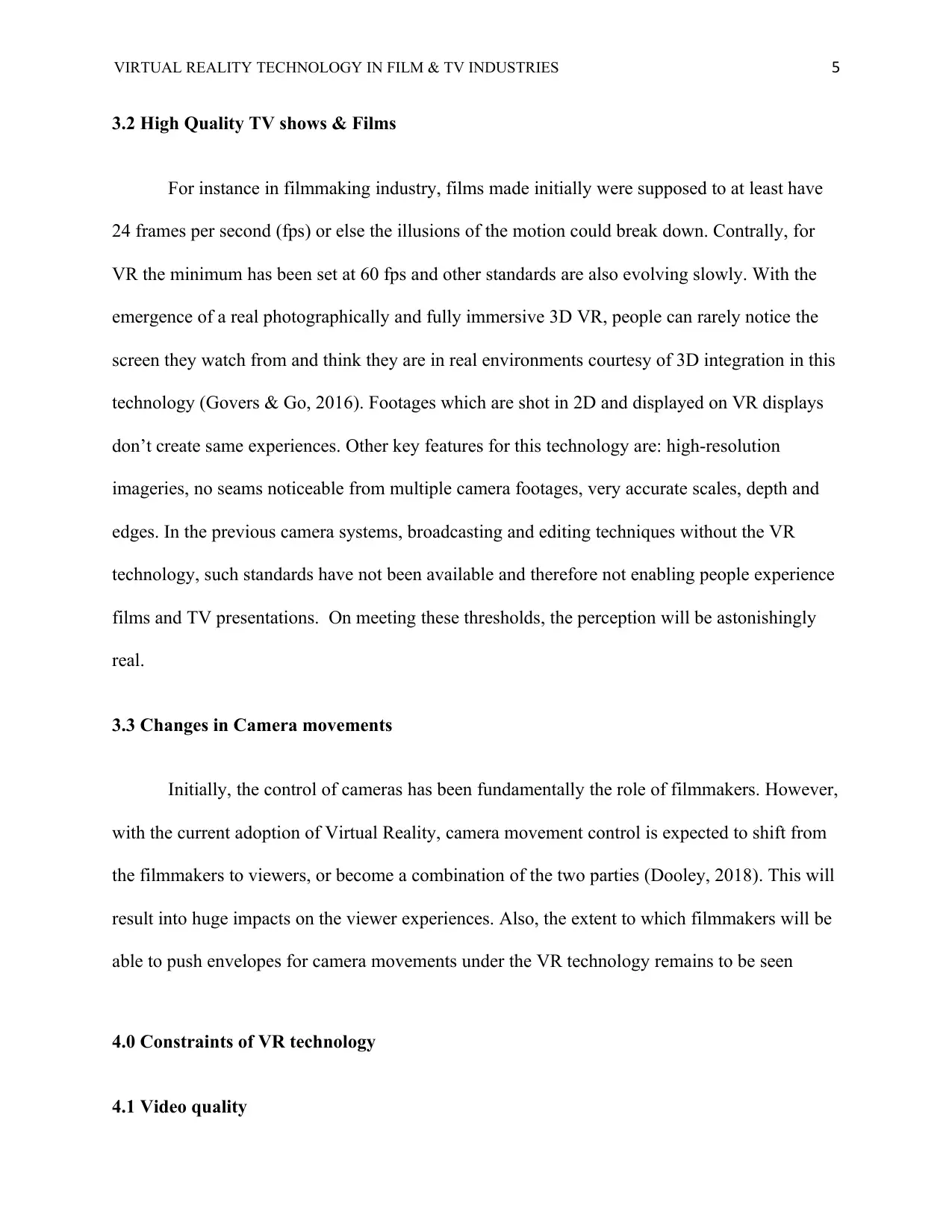
VIRTUAL REALITY TECHNOLOGY IN FILM & TV INDUSTRIES 5
3.2 High Quality TV shows & Films
For instance in filmmaking industry, films made initially were supposed to at least have
24 frames per second (fps) or else the illusions of the motion could break down. Contrally, for
VR the minimum has been set at 60 fps and other standards are also evolving slowly. With the
emergence of a real photographically and fully immersive 3D VR, people can rarely notice the
screen they watch from and think they are in real environments courtesy of 3D integration in this
technology (Govers & Go, 2016). Footages which are shot in 2D and displayed on VR displays
don’t create same experiences. Other key features for this technology are: high-resolution
imageries, no seams noticeable from multiple camera footages, very accurate scales, depth and
edges. In the previous camera systems, broadcasting and editing techniques without the VR
technology, such standards have not been available and therefore not enabling people experience
films and TV presentations. On meeting these thresholds, the perception will be astonishingly
real.
3.3 Changes in Camera movements
Initially, the control of cameras has been fundamentally the role of filmmakers. However,
with the current adoption of Virtual Reality, camera movement control is expected to shift from
the filmmakers to viewers, or become a combination of the two parties (Dooley, 2018). This will
result into huge impacts on the viewer experiences. Also, the extent to which filmmakers will be
able to push envelopes for camera movements under the VR technology remains to be seen
4.0 Constraints of VR technology
4.1 Video quality
3.2 High Quality TV shows & Films
For instance in filmmaking industry, films made initially were supposed to at least have
24 frames per second (fps) or else the illusions of the motion could break down. Contrally, for
VR the minimum has been set at 60 fps and other standards are also evolving slowly. With the
emergence of a real photographically and fully immersive 3D VR, people can rarely notice the
screen they watch from and think they are in real environments courtesy of 3D integration in this
technology (Govers & Go, 2016). Footages which are shot in 2D and displayed on VR displays
don’t create same experiences. Other key features for this technology are: high-resolution
imageries, no seams noticeable from multiple camera footages, very accurate scales, depth and
edges. In the previous camera systems, broadcasting and editing techniques without the VR
technology, such standards have not been available and therefore not enabling people experience
films and TV presentations. On meeting these thresholds, the perception will be astonishingly
real.
3.3 Changes in Camera movements
Initially, the control of cameras has been fundamentally the role of filmmakers. However,
with the current adoption of Virtual Reality, camera movement control is expected to shift from
the filmmakers to viewers, or become a combination of the two parties (Dooley, 2018). This will
result into huge impacts on the viewer experiences. Also, the extent to which filmmakers will be
able to push envelopes for camera movements under the VR technology remains to be seen
4.0 Constraints of VR technology
4.1 Video quality
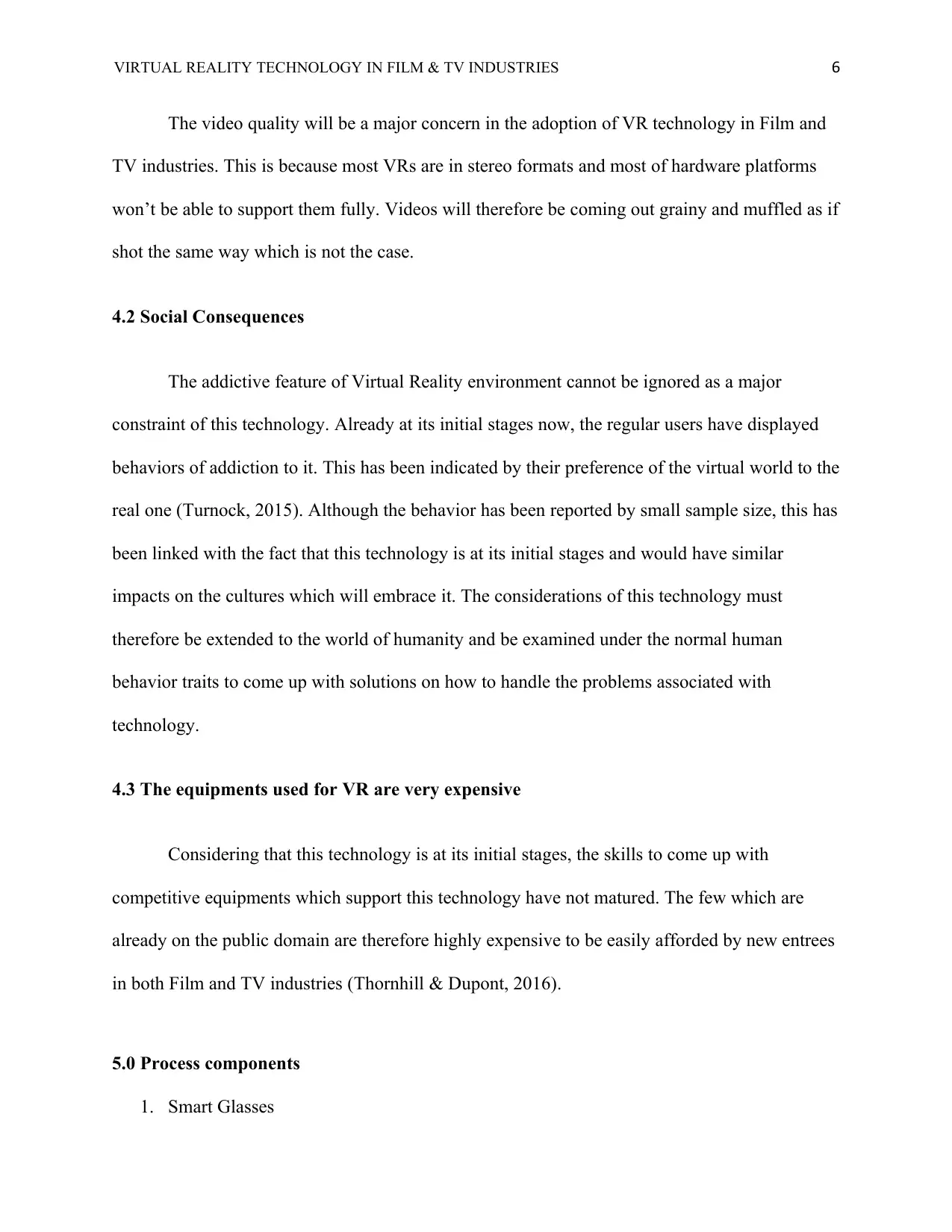
VIRTUAL REALITY TECHNOLOGY IN FILM & TV INDUSTRIES 6
The video quality will be a major concern in the adoption of VR technology in Film and
TV industries. This is because most VRs are in stereo formats and most of hardware platforms
won’t be able to support them fully. Videos will therefore be coming out grainy and muffled as if
shot the same way which is not the case.
4.2 Social Consequences
The addictive feature of Virtual Reality environment cannot be ignored as a major
constraint of this technology. Already at its initial stages now, the regular users have displayed
behaviors of addiction to it. This has been indicated by their preference of the virtual world to the
real one (Turnock, 2015). Although the behavior has been reported by small sample size, this has
been linked with the fact that this technology is at its initial stages and would have similar
impacts on the cultures which will embrace it. The considerations of this technology must
therefore be extended to the world of humanity and be examined under the normal human
behavior traits to come up with solutions on how to handle the problems associated with
technology.
4.3 The equipments used for VR are very expensive
Considering that this technology is at its initial stages, the skills to come up with
competitive equipments which support this technology have not matured. The few which are
already on the public domain are therefore highly expensive to be easily afforded by new entrees
in both Film and TV industries (Thornhill & Dupont, 2016).
5.0 Process components
1. Smart Glasses
The video quality will be a major concern in the adoption of VR technology in Film and
TV industries. This is because most VRs are in stereo formats and most of hardware platforms
won’t be able to support them fully. Videos will therefore be coming out grainy and muffled as if
shot the same way which is not the case.
4.2 Social Consequences
The addictive feature of Virtual Reality environment cannot be ignored as a major
constraint of this technology. Already at its initial stages now, the regular users have displayed
behaviors of addiction to it. This has been indicated by their preference of the virtual world to the
real one (Turnock, 2015). Although the behavior has been reported by small sample size, this has
been linked with the fact that this technology is at its initial stages and would have similar
impacts on the cultures which will embrace it. The considerations of this technology must
therefore be extended to the world of humanity and be examined under the normal human
behavior traits to come up with solutions on how to handle the problems associated with
technology.
4.3 The equipments used for VR are very expensive
Considering that this technology is at its initial stages, the skills to come up with
competitive equipments which support this technology have not matured. The few which are
already on the public domain are therefore highly expensive to be easily afforded by new entrees
in both Film and TV industries (Thornhill & Dupont, 2016).
5.0 Process components
1. Smart Glasses
⊘ This is a preview!⊘
Do you want full access?
Subscribe today to unlock all pages.

Trusted by 1+ million students worldwide
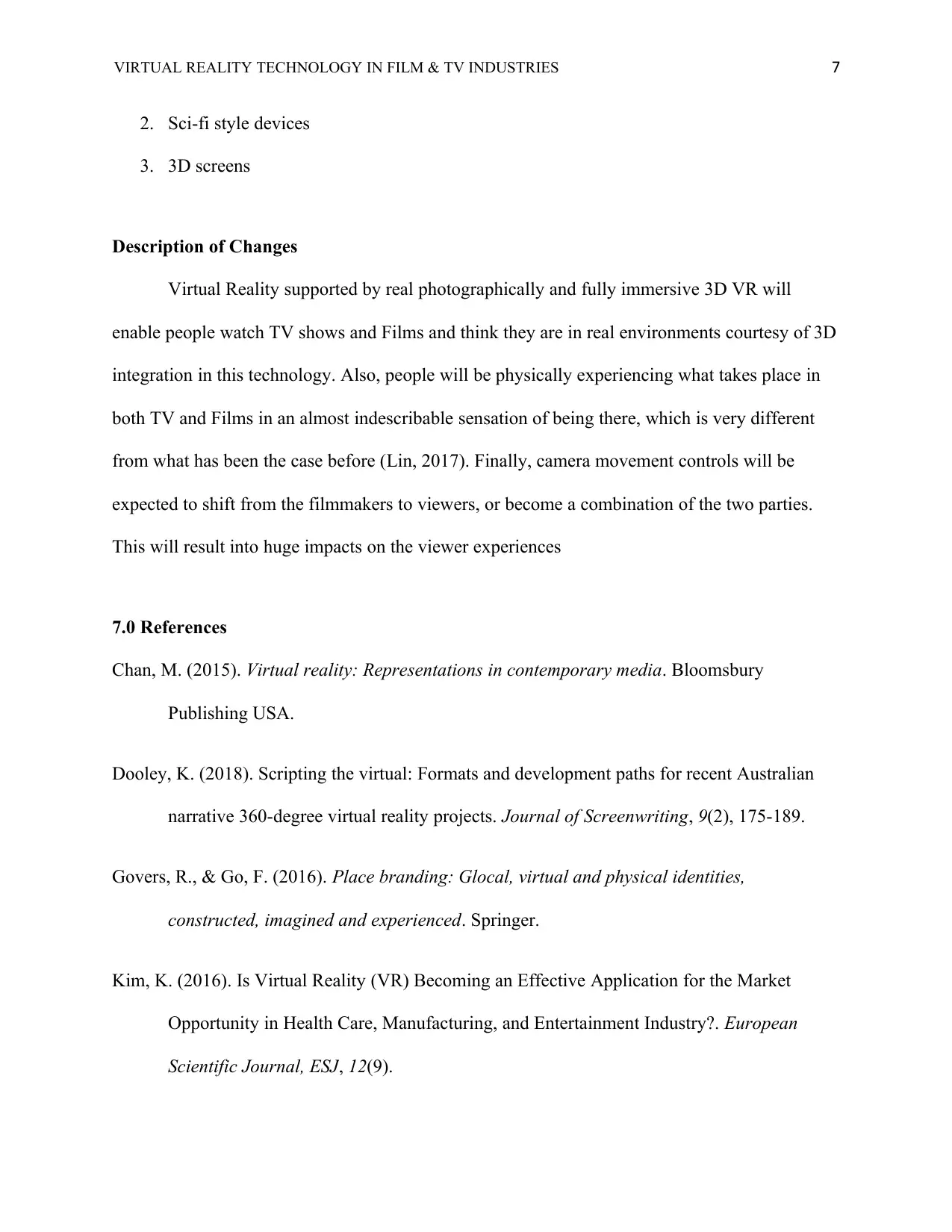
VIRTUAL REALITY TECHNOLOGY IN FILM & TV INDUSTRIES 7
2. Sci-fi style devices
3. 3D screens
Description of Changes
Virtual Reality supported by real photographically and fully immersive 3D VR will
enable people watch TV shows and Films and think they are in real environments courtesy of 3D
integration in this technology. Also, people will be physically experiencing what takes place in
both TV and Films in an almost indescribable sensation of being there, which is very different
from what has been the case before (Lin, 2017). Finally, camera movement controls will be
expected to shift from the filmmakers to viewers, or become a combination of the two parties.
This will result into huge impacts on the viewer experiences
7.0 References
Chan, M. (2015). Virtual reality: Representations in contemporary media. Bloomsbury
Publishing USA.
Dooley, K. (2018). Scripting the virtual: Formats and development paths for recent Australian
narrative 360-degree virtual reality projects. Journal of Screenwriting, 9(2), 175-189.
Govers, R., & Go, F. (2016). Place branding: Glocal, virtual and physical identities,
constructed, imagined and experienced. Springer.
Kim, K. (2016). Is Virtual Reality (VR) Becoming an Effective Application for the Market
Opportunity in Health Care, Manufacturing, and Entertainment Industry?. European
Scientific Journal, ESJ, 12(9).
2. Sci-fi style devices
3. 3D screens
Description of Changes
Virtual Reality supported by real photographically and fully immersive 3D VR will
enable people watch TV shows and Films and think they are in real environments courtesy of 3D
integration in this technology. Also, people will be physically experiencing what takes place in
both TV and Films in an almost indescribable sensation of being there, which is very different
from what has been the case before (Lin, 2017). Finally, camera movement controls will be
expected to shift from the filmmakers to viewers, or become a combination of the two parties.
This will result into huge impacts on the viewer experiences
7.0 References
Chan, M. (2015). Virtual reality: Representations in contemporary media. Bloomsbury
Publishing USA.
Dooley, K. (2018). Scripting the virtual: Formats and development paths for recent Australian
narrative 360-degree virtual reality projects. Journal of Screenwriting, 9(2), 175-189.
Govers, R., & Go, F. (2016). Place branding: Glocal, virtual and physical identities,
constructed, imagined and experienced. Springer.
Kim, K. (2016). Is Virtual Reality (VR) Becoming an Effective Application for the Market
Opportunity in Health Care, Manufacturing, and Entertainment Industry?. European
Scientific Journal, ESJ, 12(9).
Paraphrase This Document
Need a fresh take? Get an instant paraphrase of this document with our AI Paraphraser
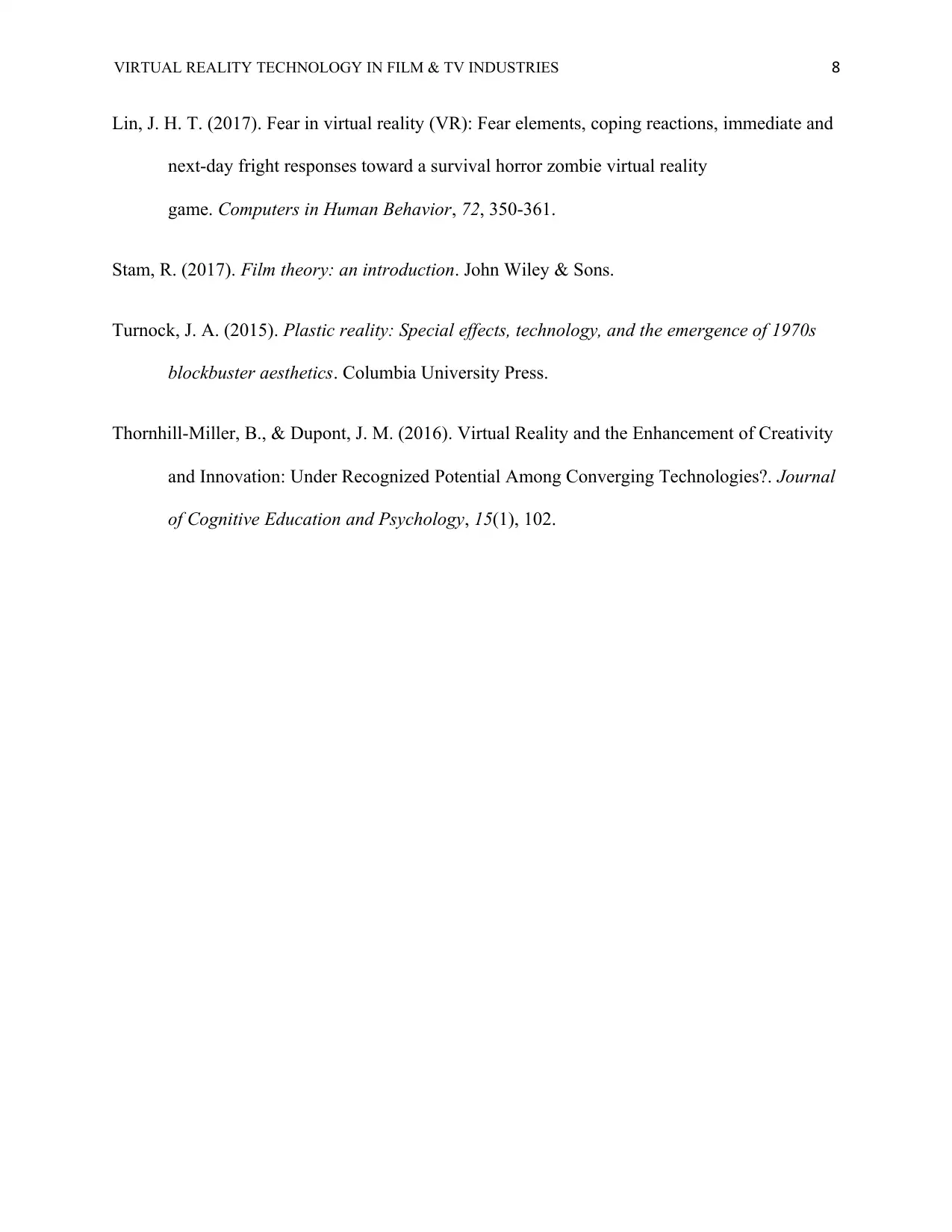
VIRTUAL REALITY TECHNOLOGY IN FILM & TV INDUSTRIES 8
Lin, J. H. T. (2017). Fear in virtual reality (VR): Fear elements, coping reactions, immediate and
next-day fright responses toward a survival horror zombie virtual reality
game. Computers in Human Behavior, 72, 350-361.
Stam, R. (2017). Film theory: an introduction. John Wiley & Sons.
Turnock, J. A. (2015). Plastic reality: Special effects, technology, and the emergence of 1970s
blockbuster aesthetics. Columbia University Press.
Thornhill-Miller, B., & Dupont, J. M. (2016). Virtual Reality and the Enhancement of Creativity
and Innovation: Under Recognized Potential Among Converging Technologies?. Journal
of Cognitive Education and Psychology, 15(1), 102.
Lin, J. H. T. (2017). Fear in virtual reality (VR): Fear elements, coping reactions, immediate and
next-day fright responses toward a survival horror zombie virtual reality
game. Computers in Human Behavior, 72, 350-361.
Stam, R. (2017). Film theory: an introduction. John Wiley & Sons.
Turnock, J. A. (2015). Plastic reality: Special effects, technology, and the emergence of 1970s
blockbuster aesthetics. Columbia University Press.
Thornhill-Miller, B., & Dupont, J. M. (2016). Virtual Reality and the Enhancement of Creativity
and Innovation: Under Recognized Potential Among Converging Technologies?. Journal
of Cognitive Education and Psychology, 15(1), 102.
1 out of 8
Related Documents
Your All-in-One AI-Powered Toolkit for Academic Success.
+13062052269
info@desklib.com
Available 24*7 on WhatsApp / Email
![[object Object]](/_next/static/media/star-bottom.7253800d.svg)
Unlock your academic potential
Copyright © 2020–2025 A2Z Services. All Rights Reserved. Developed and managed by ZUCOL.



